
I thought this bag was older than 15 years. Checking my financial program, Quicken, I found it was purchased 15 years ago for $360 at Adventure 16 (a.k.a. A16). A16, a stellar company with expert and knowledgable employees, was my favorite backpacking retailer for decades.
When I bought this sleeping bag, it was in person at one of their stores. Not only could the staff make excellent recommendations, they had a room set aside just for trying out sleeping bags. Of course, there were numerous sleeping pads on the floor for this purpose.
Alas, A16 is gone, dying at the age of 58 years. A victim of the public’s preference for cheap internet goods, while ignoring the value of knowledgable sales people and hands-on inspection before making a purchase.
If you want a quality sleeping bag, and don’t live near a brick and mortar store that sells backpacking equipment — you can’t go wrong by buying a Western Mountaineering sleeping bag, quilt, or other apparel. They are that good! Plus, everything is made in the good ‘ol US of A.
Before getting into the nitty-gritty of the Western Mountaineering (WM) UltraLite, I thought it would be helpful to review my thought processes and goals for the purchase of this new sleeping bag.
Going “Ultralight”
In 2008, as I approached the age of 60, I began to evaluate my gear, all of which had been purchased in the ‘60s, ‘70s and ‘80s, with the goal of lightening the total weight of my backpack. As we age, we get slower and weaker. In my mind, a lighter kit would allow me to continue backpacking at the same, or a similar level, as when I was younger. That thought process has held true, even as I am in my 7th decade on the planet.
The very first ulralight item on my list was a new sleeping bag. I had owned several over the previous 40 years, and my go to sleeping bag was a goose down piece I had purchased in 1971. It was still very functional, had retained its loft, and the shell material was still in great shape. But it weighed almost 4 pounds.
My plan was to buy a warm winter bag first, and in the future, something lighter for warmer weather.
Not trusting the internet reviewers, nor advertising-driven magazines like Backpacker or Outside, I headed, as I had in 1971, to a store with expert advisors.
Back in 1977, I had purchased my first pieces of gear from Adventure 16 (A16) in La Mesa, California. Not only did they carry major brands, they also manufactured some gear of their own. More importantly, they had real experts that could offer excellent and knowledgable advice.
Unfortunately, today these kind of stores are few, and most people don’t live near one to inspect and try out a purchase, which is the purpose of this post — to provide information.
As usual, I don’t like to review a product unless I have used it for at least 10 years.
My Sleeping Bag Requirements
Lightweight But Warm
Warm down to 20° F (-7° C). This means quality goose down for where I hike. It also means manufacturers are often misleading in their ratings, even the so-called standards (EN and ISO ratings) might not meet the real-world needs of the consumer.
Although I had never owned a “mummy bag,” I knew this is the lightest option (other than a specialized quilt). I also knew that mummy bags are really designed for people who sleep on their backs — I’m a side sleeper.
Durable
Lightweight and durable are usually not complimentary. Durable usually means heavier with quality components.
Budget
For me, and most backpackers, there are four components to consider when buying gear: weight, durability, function, and price. My desire was to buy a new warm sleeping bag that would last for the rest of my life. So budget wasn’t a concern at the time.
The Salesman’s Recommendation
A16 had a huge inventory of sleeping bags from many manufacturers. There were so many options to choose from. After reviewing my needs and the features I wanted, the salesman, without hesitation, said there was one perfect match for me — a Western Mountaineering UltraLite. It checked off all the requirements on my list.
Western Mountaineering has been in business for over 50 years and among backpackers and mountaineers it is a premium brand with equipment and apparel that does exactly what the manufacturer promises.
The Road Test
The salesman was pretty adamant that I tried out the sleeping bag before purchasing. A16 had a large room with air mattresses and foam pads on the ground. It was their “road test” room. He wanted me to try it out for at least 30 minutes.
After my 30 minute road test, I was sold.
Western Mountaineering UltraLite Specifications

Here’s a link to the table of specifications for all of Western Mountaineering’s sleeping bags and quilts. As you will see, Western Mountaineering offers a plethora of sleeping solutions to meet just about any need.
Mummy Bag
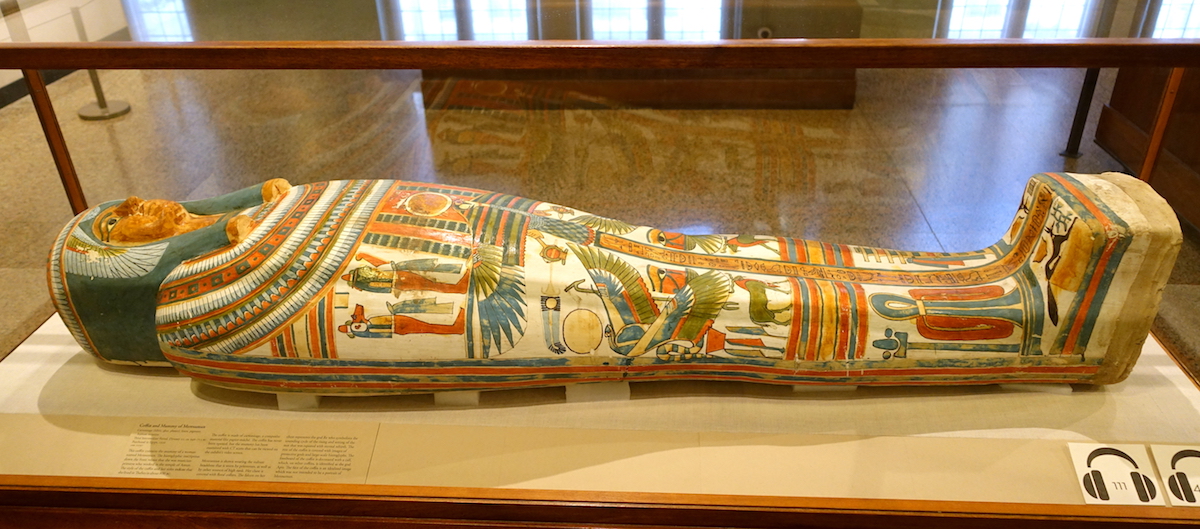
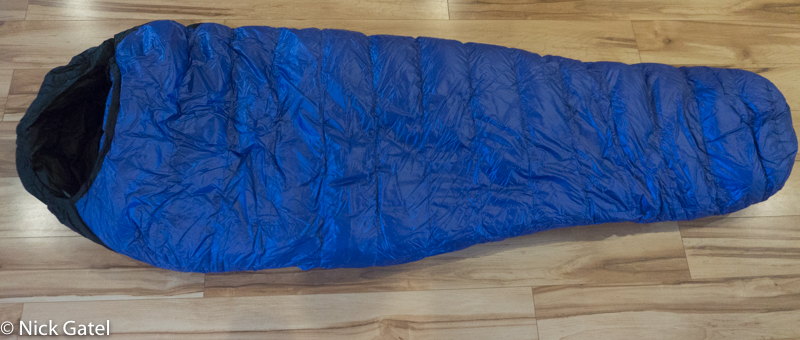
As it turned out, being a side sleeping, I don’t have difficulty with this bag. Usually I sleep under the stars and end my evening in camp laying on my back looking at the night sky. I fall asleep in this position. During the night, while sleeping, I do turn to my sides, but it is unconscious. Being thin in stature, I usually do this inside the bag, not turning the whole bag in concert with my body. I stay warm.
Others may have different results and might need a different solution.
Construction
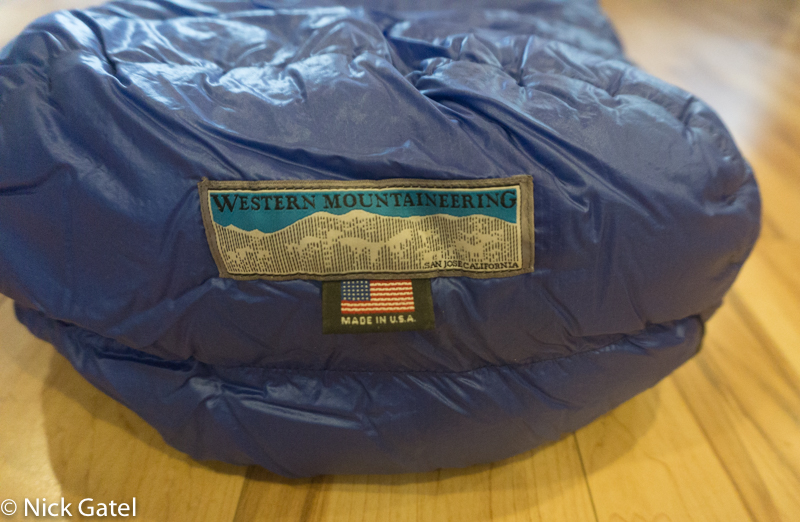
Goose Down

My bag is the 6’0” size. the loft is 5.5 inches (2.75 inches on the top and the bottom).
In my article on Down Fill Power Explained — Is it an Important Measurement? I provided a table with data from the US Army Natick Laboratory on insulation thickness to temperature (see below).
The loft is shown as 5 inches at the top of the Western Mountaineering spec sheet, which matches the Natick Data Lab Report, but in WM’s table below it, it shows 5.5 inches. I have noticed this in most of their sleeping bags. Since it is insulated top and bottom, the insulation thickness is either 2.5 inches or 2.75 inches using their table. From my table on sleeping bag thicknesses posted earlier, the UltraLite, using the 5 inch number matches the insulation value of 2.5 inches for 20° F provided in the Natick Lab report. So why the difference? Perhaps WM’s explanation of their Down Fill Power will add some clarification:
Western Mountaineering is specialized enough that we can ask for our suppliers to give us the best down they can get. This creates an average yield that is almost always above 900 fill power. We state 850+ on our products because even though the down tests out at 900 or over, the ‘real’ loft power is different. Once the down is inside a bag or jacket baffle it is compressed slightly by the fabric. Loft is also affected by real world humidity conditions that are not present during loft testing.
Instead of the 2.5 inches of insulation in the table, Western Mountaineering uses 2.75 inches of 850+ Fill Power European goose down. Thus, instead of being warm at 20° F, this bag is comfortably warm. They “rate” it as 5 inches of down.
Note that the 6’0″ bag has 16 ounces of down and a total weight of 1 lb. 13 oz. This is what my UltraLite actually weighed when I got it home. Often times, the stated weights on a manufacturer’s website for all kinds of gear doesn’t match what you get.
Keep in mind that temperature ratings are for “average” people. Individual results vary and most women need more insulation than men.
Shell
Western Mountaineering states the shell is made from their ExtremeLite material. What that material is I don’t know. The material is tough and shows no sign of wear or degradation over the past few years. In addition, unlike all the other sleeping bags and quilts I have owned over the years, no down escapes through the shell. There is never a stray piece of down that has come through the shell.
Continuous Horizontal Baffles

The UltraLite uses horizontal baffles that are spaced 5.25 inches apart. The baffles encircle the bag from zipper to zipper, so the fill doesn’t migrate during the night. It also allows the user to manually push the down from the top to the sides for warmer temperatures, reducing the amount of down on the top of the bag.
I have never tried to do this, finding it easier to unzip the bag or even open it up and use it like a quilt.
Zipper
A full-length #5 YKK zipper is used. It can be opened at both the top and the bottom to provide ventilation in warmer weather. The zipper is robust. In addition, unlike other down products I have owned, the zipper never, ever, catches on the material. It always works flawlessly.
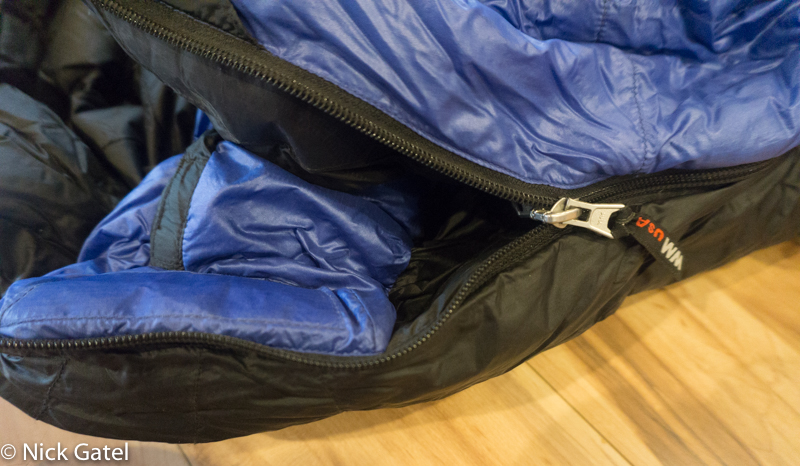
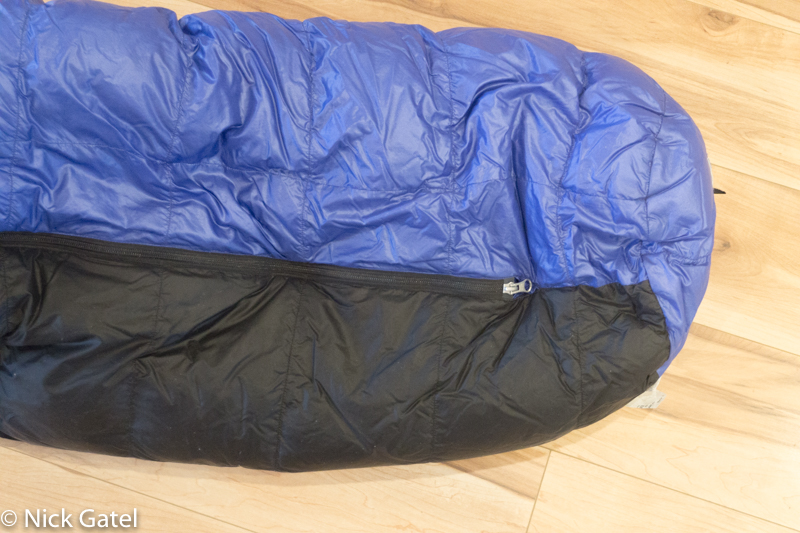
Coupling Sleeping Bags
Some WM sleeping bags can be coupled together. From the website:
All 6’0″ and 6’6″ bags are compatible as long as one is right zip and the other is left zip. 5’6″ bags can be zipped to 6’0″ and 6’6″ bags, but will not line up properly at the top of the zipper. To couple unzip both bags completely. Then attach each zipper side to the opposing side and zip up! Semi rectangular bags can also be zipped together. If you have an older bag with a #7 zipper you can use a 5 to 7 zipmate, available to special order at an Western Mountaineering dealer, to attach it to a bag with a #5 zipper.
Zipper Draft Baffle
To prevent drafts, a down filled baffle runs along each zipper.
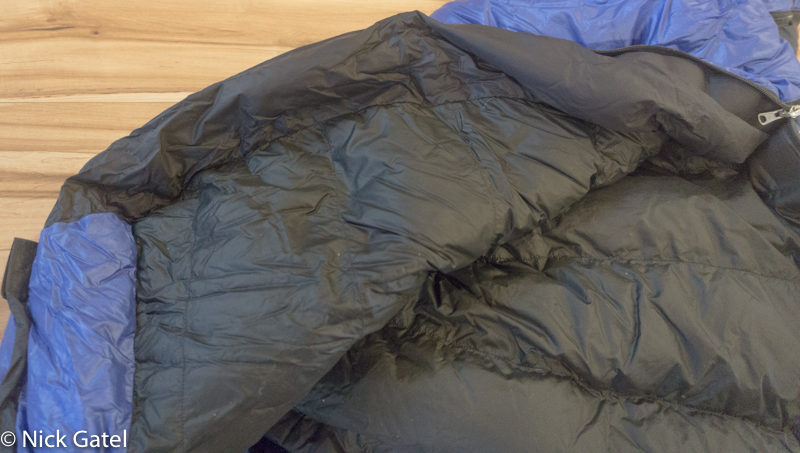
Down Filled Draft Collar
To prevent heat escaping at night as you move around, an adjustable draft collar (the long blue collar) can be cinched down. The collar encircles the entire width of the sleeping bag.
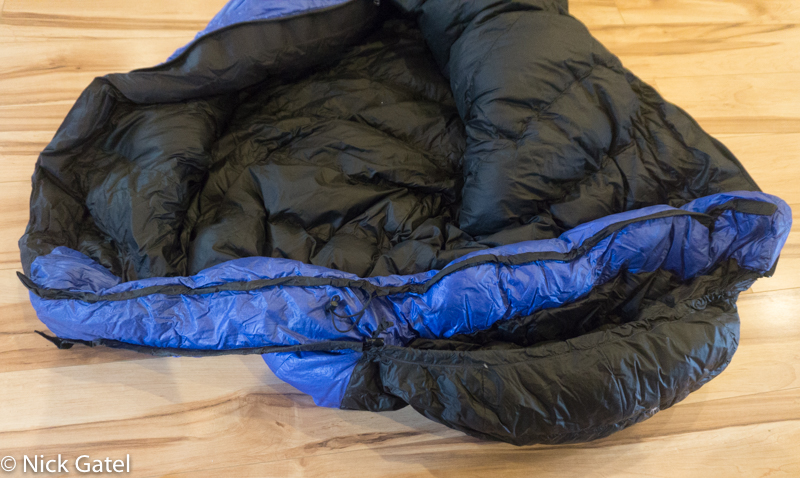
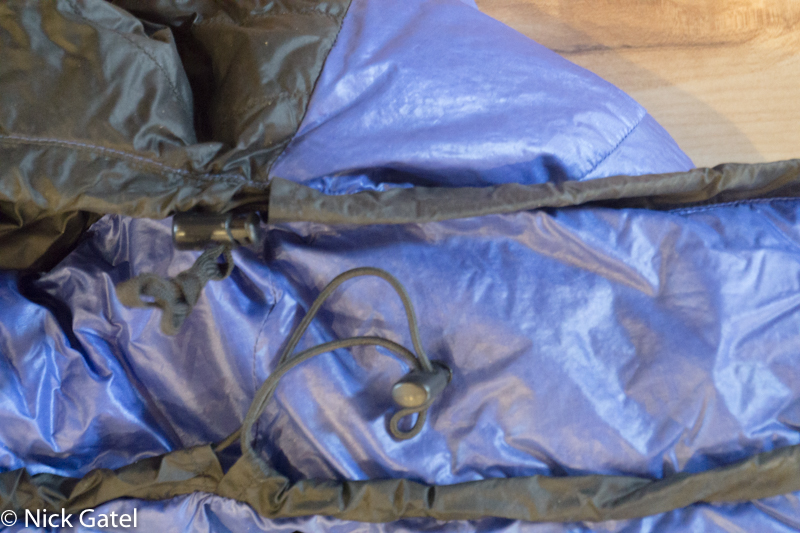
(Above) The lower cinch cord tightens the draft collar and the upper cord allows the hood to be adjusted.
Storage Bag
Included is a large cotton bag to store the sleeping bag uncompressed. The cinch cord is long enough to hang the storage bag from a hook, which I find convenient. This is how I store all my sleeping quilts and bags.

Stuff Sack
It even comes with a stuff sack. I rarely use stuff sacks for sleeping bags or quilts, as the cylindrical shape wastes space. Instead, my sleeping bag is stuffed into the bottom of my pack, filling every nook and cranny. Keep in mind that one has to be careful to protect the bag from getting wet— either water coming into the pack from the outside, or something that is inside the pack such as a water bottle.
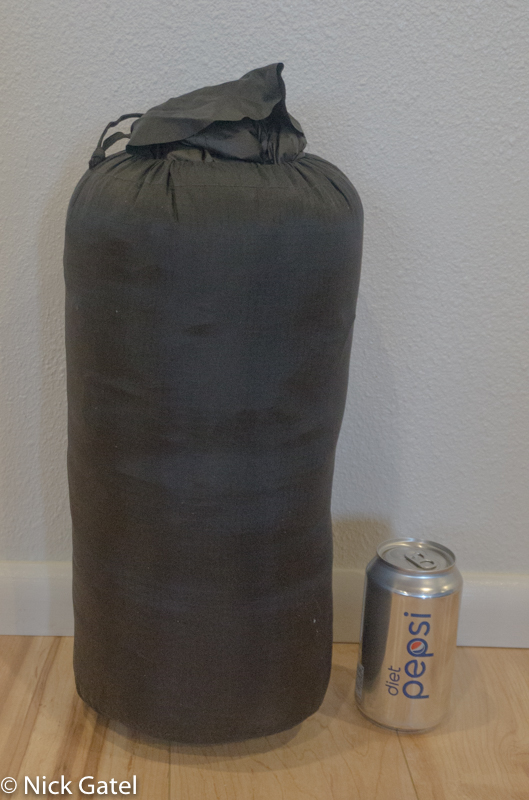
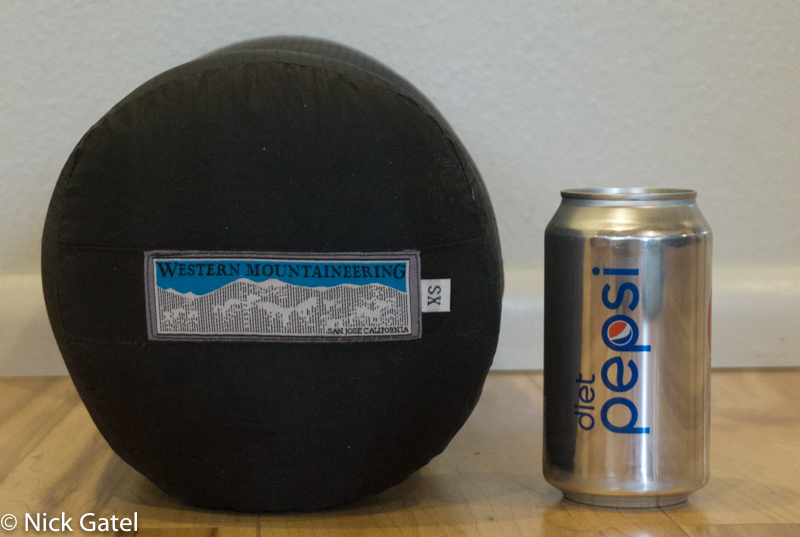
The logo on the bottom of the stuff sack also functions as a pull sleeve to easily hold the stuff sack while pulling the sleeping bag out of the other end.
Where to Buy
Western Mountaineering does not sell direct to the public. In addition, they have agreements with their dealers not to sell any product for less than the manufacturer’s recommended list price. Also dealers cannot sell products to other countries that have Western Mountaineering dealers. So if you live in Australia, for example, you cannot buy a product from a United States retailer and have it shipped to you.
This website may be compensated for linking to other sites for sales of products. As an associate I earn a small fee from qualifying purchases at no additional cost to the purchaser.
